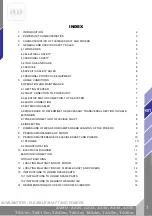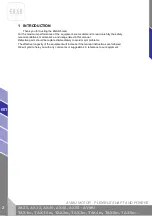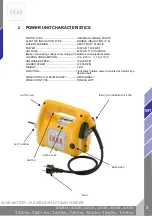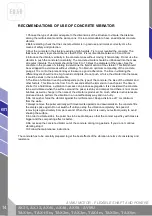
AVMU MOTOR - FLEXIBLE SHAFT AND POKERS
7
en
AVMU - AX25, AX32, AX40, AX48, AX58
TAX1m, TAX1-5m, TAX2m, TAX3m, TAX4m, TAX5m, TAX6m
5
USAGE CONDITIONS
For your own safety, as protection for others, and to avoid damage to the equipment, read carefully
the usage recommendations.
1. Before working, to be sure the hose joint nut is fastened to the motor (screwed to left).
2. Be sure the poker is well screwed to the flexible shaft (screwed to left).
3. Do not work with flexible shaft with big bends.
4. Do not overlubricate the shaft.
5. Do not keep working the poker out of the concrete more than 5 minutes.
6. Do not restrict the movement of the poker during the work.
7. Do not stop the poker inside the concrete.
8. Change the wear parts to avoid damage to the internal parts. (Check wearing table for the poker)
9. Do the maintenance with the kinds and quantities of recommended lubricants.
IN ADDITION, LOCAL COUNTRY ESTABLISHED ORDINANCES SHOULD BE RESPECTED.
6
OPERATION AND MAINTENANCE
6.1 GETTING STARTED
Read item 5 USAGE CONDITIONS
6.2 SHAFT CONECTION TO POWER UNIT
Power unit is designed to facilitate a quick and safe connection to flexible shaft.
CONNECTION PROCEDURE:
1. Introduce power unit hexagonal axle into the provided shaft housing
2. Screw plastic nut of shaft to aluminium thread of power unit . (Be aware of nut turns left and not
tool is required)
CONNECTION CHOICES :
FLEXIBLE SHAFT LENGTH:
TO 6 MTS (TAX1M, TAX1,5M,TAX2M, TAX3M, TAX4M, TAX5M,
TAX6M)
VIBRATOR DIAMETER :
TO 58 MM DIAMETER (AX25, AX32, AX40, AX48 AND AX58)
6.3 ELECTRIC MOTOR CONECTION TO THE SYSTEM
Turn off the motor switch before connecting it.
6.4 EARTH CONNECTION
On motors that have plug with earth, to protect the user from an electrical shock, the motor should
be correctly connected to earth.
6.5 EXTENSION CABLES
On motors that have plug with earthing, always use extension cables with earth wire and its
respective plug with earth in the female and male switches, those which will use the male switch on
the motor.
Do not use damaged or worn out cables.
To avoid heavy loads on top of cables.
To determine the transversal section, follow the following procedure































